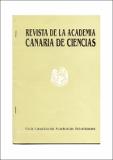Please use this identifier to cite or link to this item:
http://hdl.handle.net/10261/3086Share/Export:
 SHARE
BASE SHARE
BASE
|
|
| Visualizar otros formatos: MARC | Dublin Core | RDF | ORE | MODS | METS | DIDL | DATACITE | |

| Title: | Evolución geológica y magmática de la Isla de Lanzarote (Islas Canarias) |
Authors: | Carracedo, Juan Carlos CSIC ORCID; Rodríguez Badiola, Eduardo CSIC | Keywords: | Lanzarote Evolución gelógica y magmática Islas Canarias |
Issue Date: | 1993 | Publisher: | Academia Canaria de Ciencias | Citation: | Revista de la Academia Canaria de Ciencias V(Núm. 4): 25-58 (1993) | Abstract: | The results obtained indicate that the building of the subaerial stage of construction of Lanzarote began during the Miocene and is characterized by the formation of two main basaltic “island-edifices”: Los Ajaches, built in a relatively short and continued period of about 1 Ma of reversed polarity in the Middle Miocene, and Famara, constructed in three progressively shorter late Miocene-Pliocene eruptive phases corresponding respectively to Epoch 9 of normal polarity at about 10.2 to 8.7 Ma, Epoch 6 of reversed polarity (6.5 to 5.7 Ma) and the Cochity normal polarity event (3.9 to 3.8 Ma) in the Gilbert Epoch. After a prolonged period of eruptive repose of about 2 Ma, eruptive activity resumed in the island in the middle Matuyama reverse polarity Epoch, with basaltic magmas and fissure eruptions that continued until quite recently (1824), with an eruptive episode of an anomalously high magnitude between 1730 and 1736. The evolutive trends of the related magmas show the presence of a complete evolutive magmatic cycle in the old edifice of Los Ajaches, with magmas evolving by crystal fractionation from alkali basalts to trachytes. In Famara and Tías edifices, magmas are mainly primitive basanites generated by partial melting processes. In the Quaternary volcanism, partial melting-generated basanite-alkali basalt magmas are also predominant, with some superimposed components of crystal fractionation. A significant exception is the 1730 eruption, where the evolution of magmas is completely anomalous in the recent magmatic history of the Archipelago, from basanites to olivine tholeiites, probably in relation with the mixing of magmas from two different magmatic sources. | URI: | http://hdl.handle.net/10261/3086 | ISSN: | 1130-4723 |
| Appears in Collections: | (MNCN) Artículos (IPNA) Artículos |
Files in This Item:
| File | Description | Size | Format | |
|---|---|---|---|---|
| Evolucion Lanzarote-RevAcadCanCien.pdf | 2,28 MB | Adobe PDF |  View/Open |
CORE Recommender
Page view(s)
566
checked on Apr 22, 2024
Download(s)
517
checked on Apr 22, 2024
Google ScholarTM
Check
WARNING: Items in Digital.CSIC are protected by copyright, with all rights reserved, unless otherwise indicated.
